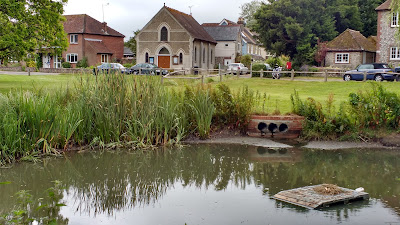The Lavant valley - Saturday 24th June
From Chichester, a circular walk to East Dean, via East Lavant, The Trundle via Chalkpit Lane,
Goodwood Road, Monarch’s Way down to East Dean. Back along the Lavant valley to
Charlton and Singleton. Up the hill from Singleton church. Back via Hayes Down
and the Centurion Way.
In a change from last week's heatwave, the day started with drizzle, light rain on the way out of
Chichester to East Lavant. The Trundle foggy, with low cloud, and no view at all from the top. After coming down the west side of the hill and crossing Goodwood Road, the stretch of road walking near / past the racecourse,
a bit of an obstacle course. There was a high-class do on in the posh grandstand reception
area, but the large areas cordononed off opposite the grandstands was most likely in preparation
for the Festival Speed next weekend. Essentially that takes over the whole area, leading to widespread, lengthy traffic queues. If not going to the event, the whole West Sussex area best avoided by road while it's on. Given the jams, the festival has always seemed
ironically named.
My main issue now was, something I’d
forgotten about amid of the dry weather: feet / trouser bottoms wet, thanks to wet
long grass, even if soil very dry and much of the grass browning. Worse than
usual as feet and socks wet through, thanks to trainers well on their way out and overdue for replacement.
Followed Monarch's Way along road east
to where it turned left off the road to go down the north side of the ridge to
through the woods to East Dean. The last bit out of the woods near the foot of the hill
to the lane down to East Dean, over stile very overgrown, long grass alongside
barley field.
 |
| East Dean pond |
Began the return leg of the walk along the valley of the absentee river to Singleton. Along the road to Charlton, most of the traffic seemingly bound for, parked by what a took to be the Charlton gastro pub. From Charlton, left off road, through field to Singleton. Path overgrown where it left the field at the western end at end. Very long grass, though by now dried out, hill clear now, too. Uphill from Singleton church to Trundle.
Back down to Chichester via Hayes Down, sat over looking the view across the valley below West Dean. Of all the views along the South Downs, this is the one I've probably sketched the most times, upteen times during the past eight years. In winter, usually water in the stream running across a large field below the main road, crossed at the southern end by the Centurion Way cycle path coming down from the road before turning south. Before following this path back into the city centre, I had a quick, closer look down there. Compare and contrast photos of the dry riverbed now with the same view during the ages of abundance, which began with the unusually wet, recharging spring and summer of 2012; and included winters 2012/13 and 2013/14. Groundwater flooding on the road in East Dean, pumps at Singleton.
Then and now photos from winters 2012/13,
2013-14 Groundwater flooding around East Dean.
 |
| Along the Centurion Way above Mid Lavant |


